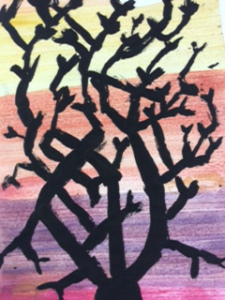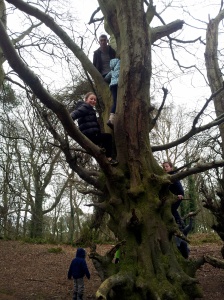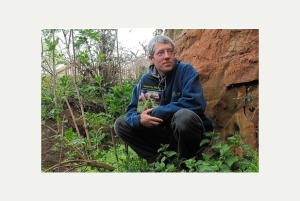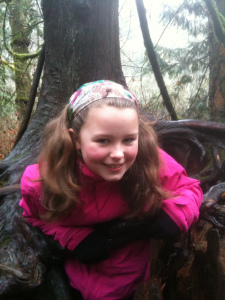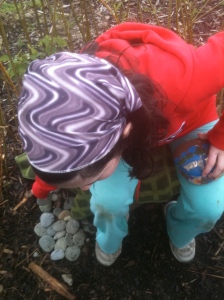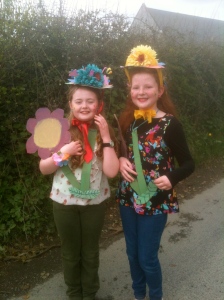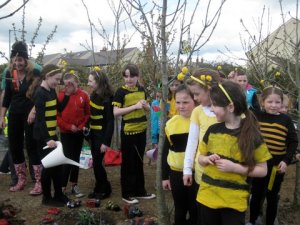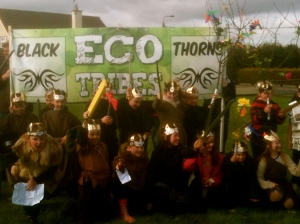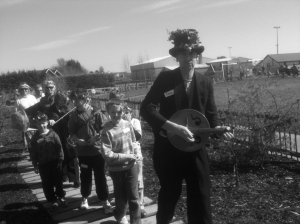A Celtic Garden
August 30, 2017
A Celtic Garden was developed by six primary schools in County Louth within their local communities. Each primary school developed a name for their Celtic themed garden and a motto for their project. A public event, was created by each school to celebrate the Celtic season of Bealtaine (connected to the summer growing season).
The children generated festivity through music, drama, dance, poetry, and colourful processions. Local residents, teachers and family members were in attendance and welcomed the addition of a new community garden. Herbal teas, foraged food and traditional Irish dishes were also prepared and the students devised art and educational activities for their guests. The environmental aspect of the project was inspired by Irish garden designer Mary Reynolds and her book The Garden Awakening: Designs to Nurture Our Land and Ourselves.
Mary Reynolds, A Garden for Ceremony
“Create a garden that is alive with the energy and exuberance of nature…With this loving and mutually respectful relationship, you will feel forever supported, grounded and safe…My method of creating a powerfully conscious garden simply suggests using some kind of ceremony to focus your feelings and intentions into a particular form and direction. You can make up your own ritual, as long as you believe it works. Belief is the key.”



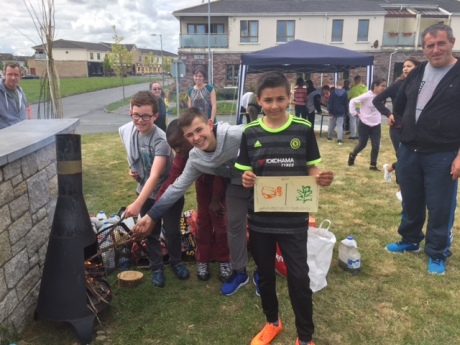

The Art of Trees
May 11, 2015
Photos: Scoil Bhride NS (Dunleer), Tree Procession and Tree Oaths Artwork by students of Scoil Naomh (Muchgrange)
Observing trees and nature can inspire children’s art and creativity. Poetry, song, dance, costumes, drawing, painting and tree dressing all emerge from a feeling of being connected to the natural world. Celebrating trees as part of a procession or special gathering, extends children’s energy and spirit into the larger community. Local residents admire the work of children seeking to make their environments special for everyone. It is the combination of trees, plants and creativity that make these gardens enchanting and engaging.
Photo: St. Peter’s National School, Tree Costumes (Dromiskin)
Children can create tree gardens as dreaming places for the hearts and minds of local communities. Their collective imagination can express the presence and energy of trees within the natural environment, and within the activities of daily life. Gardens created by children are filled with wishes, good intentions and joyful celebration. They accompany the lives of local people as acts of goodwill.
Children’s tree gardens are pubic expressions of art making that help people of all ages connect with the art of nature.
“We learn to impersonate the way nature creates- spontaneously and in relationship. We develop facility with nature’s pattern language. We create and share art in the form of stories, myths, movements, songs and images that give colour, form and life to transformative experiences with the living world. We experience nature as alive with an expression all its own”
(Reference: Bringing Art to Life: Creative Nature Education for Educators by Lisa Lipsett, http://www.creativebynature.org)
Photo: The Art of Baking, Tree Recipes by St. Francis NS, (Blackrock)
Why is Art Important?
1. It’s been proven that early exposure to visual art, music, or drama promotes cognitive activity.
2. Art helps children understand other subjects more clearly—from math and science, to language arts and geography.
3. Art nurtures inventiveness as it engages children in a process that aids in the development of self-esteem, self-discipline, cooperation, and self-motivation.
4. Participating in art activities helps children to gain the tools necessary for understanding human experience, adapting to and respecting others’ ways of working and thinking, developing creative problem-solving skills, and communicating thoughts and ideas in a variety of ways. (Reference http://www.kinderart.com, “Why is Art Education Important”)
Photos: Observational Tree Painting, St. Paul’s NS, (Walshestown) and Ardaghy NS, (Omeath) Playground Orchard Planting Event
Eco Tribes: Herbal Meadows
November 14, 2014
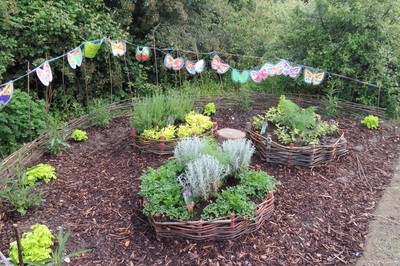

The Eco Tribes projects is an annual challenge whereby primary schools work as gangs of guerrilla gardeners transforming neglected areas of land within their local communities. Every year a different planting theme is chosen to inspire biodiversity and ecological gardening methods. The cultivation theme for 2014 was Herbal Meadows.
Each primary schools selects a unique name and symbolic tag to brand their tribe. The name of each guerrilla gardening group must be of an Irish tree, wild flower, plant or herb (i.e. The Blackthorns or The Honeysuckles). The primary schools work in close collaboration with local volunteers, school teachers and family members to promote biodiversity and landscape sustainability.
The highlight of the project is the public event organised by each school, which can take the form of a parade, outdoor music concert, traditional market, community poetry reading, folklore presentation, historical tour, or outdoor rave. The goal of each public event is environmental education and the promotion of biodiversity within village settings. Rather than solely a conservation issue, biodiversity can be a creative assembling of flowers and herbs that reflect the unique natural and social history of each locality. Many local wild plants were traditionally used for healing purposes at both a personal and community level. In the latter case, seasonal celebrations evoked the use of specific plants for rituals pertaining to the different stages of the growing year.
A Herbal Meadow is composed of both medicinal and culinary herbs, and integrates visually into local rural communities surrounded by fields and hedgerows. The Herbal Meadow blends traditional cures, wild foods, and aesthetic features to produce a complex arrangement of beneficial plants that craft ecological habitats. The gardens also act as meeting points, and places where children have redesigned their surroundings to suit themselves.
The Forest Classroom
April 7, 2014
Chris Holland is a environmental educator based in the UK. His book I Love My World is an exploration of creative activities for children to pursue in the context of forest schools.
Forest schools promote ecological learning, integrating bushcraft, environmental awareness, teamwork and personal development. Children are encouraged to make fires without matches, to identify edible plants, to carve wood, to build shelters and to collaborate on learning survival skills within forest school outdoor classrooms.
In Ireland Earth Force Education (www.earthforceeducation.com) is delivering forest school experiences to children in the context of school holiday camps, and offering training to adults interested in becoming forest school teachers. Children become exposed not only to natural habitats and changing weather conditions, but the capabilities and strengths they have within. Forest school learning is not segmented, but flows through a course of activities that teach each child how to live in relationship to the natural world.
Forest schools are an art form in themselves, creating camp like classrooms with shelters interwoven with branches and integrating features of the landscape. Environmental educations is not a subject, but a way of living, a beckoning into science, folklore, seasonal traditions, and storytelling. Chris Holland’s Forest School training includes “nature awareness, ways of making fire by friction, shelter making, knife, axe and pruning saw use, tracking, woodland bling and garden jewelery, wild food and wild medicine, campfire cookery, coppicing and rural skills as well as some storytelling activities for would-be storytellers” (Chris Holland, Wholeland Website http://www.wholeland.org.uk/for-training).
A Photo of Chris Holland with his book I Love My World.
Natural Escape Routes for Children
November 29, 2013
An empathy with the natural world can become a vital part of children’s psyches; they will learn to take nothing for granted, and will continually probe and ponder. They will have a sense of wonder and mystery about the world around them; it will become a vibrant part of their consciousness…In short, they will feel committed and responsible for the world in which they have been placed as caretakers for a brief moment of time (Paddy Madden, Go Wild at School).
The following is a summary of some of these research findings.
1. Nature enhances children’s skills in the following areas –
Problem Solving, Teamwork, Experimentation, Decision-Making, Adaptability, Confidence, Enhanced Communication, Sensory Development, Intellectual Stimulation (Carol Duffy, Childhood Specialist, Ireland)
2. Recent research proposes that exposure to the outdoors reduces anxiety, and enhances learning. (Dr. Dorothy Matthews, American Society for Microbiology)
3. “A den (made from natural materials) is the child’s sense of self being born, a chance to create a home away from home that becomes a manifestation of who they are. The den is the chrysalis out of which the butterfly is born.” (David Sobel, Antioch New England Graduate School)
4. “By bolstering children’s attention resources, green spaces may enable children to think more clearly and cope more effectively with life stress”. Engagement with natural settings has been linked to a child’s ability to focus, and enhances cognitive abilities. Nearby nature is a buffer for anxiety and adversity in children. (Dr Nancy Wells, Cornell University, New York)
5. The outdoor environment enhances the understanding of social relationships, language, physical movement, reasoning, curiosity, and the capacity to imagine possibilities. (Jane Williams-Siegfredsen, Viborg University College, Denmark)
6. Fostering children’s identity to include personal and social relationships with nature, improves their empathy and sense of inter-connection with the world-at-large. (Anita Barrows, Clinical Psychologist, Berkeley, California)
7. Nature can activate sensory, emotional, cognitive, symbolic and creative levels of human experience through de-familiarisation. Taken for granted everyday things, are sensitively given new meaning and enhance a child’s capacity to perceive. (Jan Van Boeckel, Research Fellow Aalto University Helsinki, Anthropologist, Filmmaker)
8. “Involuntary attention, as opposed to directed attention, can be cultivated within nature”. The “soft fascination” of the natural world can restore focussed attention required for directed studies. Involuntary attention is achieved without effort by simply observing what captures our attention. Our mind wanders and takes a rest from concentrated effort, which in turn improves learning. (Marc Berman, Brain Scientist, University of Michigan)
References
Paddy Madden, Go Wild at School
Children and Nature Network childrenandnature.org
Nature Art Education http://www.naturearteducation.org
A Blooming Uprising: Primary School Activists
May 9, 2013
Eco Tribes is an initiative supported by Louth County Council, which encouraged ten primary schools in County Louth to create nature friendly gardens within their communities. The students celebrated the European Year of Citizens by becoming environmental activists. They learned about garden design, how to organise community celebrations, and gardening for bees and butterflies. They also collaborated with their local Tidy Towns group to transform a neglected piece of land into a garden. Each school performed music, drama, dance, poetry, or song for their public celebration.
A garden can be a public landmark within a community. A source of pride for children, who demonstrated high levels of teamwork, organic gardening skills, creativity and performance skills.
Their research, highlighting the decline of bees and butterflies within Ireland, has also demonstrated the importance of planting cottage garden flowers, herbs, and wildflowers.
The Eco Tribes project has raised the profile of Green Schools within their communities. Their inter-generational collaboration with adults working to revive their localities, has inspired a new generation of community minded volunteers.
Eco Tribes: Guerrilla Gardening with Green Schools
February 19, 2013
Eco Tribes: The Biodiversity Challenge is supported by Louth County Council, Environment Section and the Department of the Environment, Community and Local Government.
The project will mark the European Year of Citizens 2013, by promoting active citizenship and intergenerational social activism.
Collectively the Eco Tribes will enact A Bloomin Uprising in County Louth, as they transform neglected areas of land within their local communities, into habitats for bees and butterflies.
The project also involves a media and public education event, where students will encourage their communities to cultivate flowers for bees and butterflies. Each school’s Eco Tribe will develop a ‘tag’ for their group, in the form of a name and symbol representing a native Irish tree, wildflower or plant.
Besides crafting biodiversity gardens, and learning the tactics of guerrilla gardening, students will be empowered to think about strategies to implement social change at a community level. Environmental activism encourages children to evaluate their local landscape, in order to generate goals for their campaign. The Eco Tribes projects cultivates a sense of empowerment, strategic thinking, team work and creative expression. It puts children at the forefront of social change within their communities.
The Language of Landmarks and Landscape
May 9, 2011

 LANDMARKS: NATURE, ART, SCHOOLS
LANDMARKS: NATURE, ART, SCHOOLS
Week 11 – 18 New Participants
Total Individual Children Participating: 209
Total Participation of Children: 409 (Some school classes have returned 2-3 times)
“A wonderful, magical
 experience in a back-to-nature environment. The children enjoyed a hands-on experience, and it was a great opportunity for creative and artistic expression. I loved the bird song! A chance to see and experience the wonder and beauty of art in nature and the natural environment. The resources and materials were fantastic. Thanks so much, more please!” St. Finian’s National School (Dillonstown), Teacher (3rd/4th Class).
experience in a back-to-nature environment. The children enjoyed a hands-on experience, and it was a great opportunity for creative and artistic expression. I loved the bird song! A chance to see and experience the wonder and beauty of art in nature and the natural environment. The resources and materials were fantastic. Thanks so much, more please!” St. Finian’s National School (Dillonstown), Teacher (3rd/4th Class).
The advantage of children working in a studio setting is the freedom to explore layers of instinctive marks (made with pencils, pastels, charcoal, and paint) that in essence compose a child’s own language of expression. Many drawings, words, and painted textures can be applied to sculpted paper books, so that a child creates their own landscape of identity.
Each child has a distinctive approach to their artworks and creative writing. Collecting words and impressions from natural materials, while also drawing inspiration from artists who work with nature fuels imagination. Engaging with nature, “supports a child’s sense of self, allowing children to recognise their independence alongside an interdependence and connectedness with their ecological worlds” (Play Naturally: A Review of Children’s Natural Play by Stuart Lester and Martin Maudsley, included in the Children and Nature website http://www.childreandnature.org under Research and Publications).
Experimentation within a studio environment is an invitation for children to follow their own path of discovery. The artwork is never really finished, always a “work-in-progress,” a journey in the making. “Among the many relationships that define the human condition, the individual’s connection to the environment is primary…We singular creatures… aspire to leave our mark, inscribing our observations and gestures within the landscape, attempting to translate and transgress the space within which we find ourselves (J. Kastner and B. Wallis Land and Envrionmental Art).
For children inscribing their lives within both art and nature reflects who they are within the greater canvas of the world-at-large. An empathic kinship with nature offers sensory, perceptual, and emotional opportunities for communication. For children this can be a vital source of expression, a declaration in their own artistic language.
A Collection of Words from the Landmarks Studio:
Wool wrapped up in a basket
Sticks with seaweed too
Stones and rocks all piled up as one
Shields of sticks and branches
A vase of flowers
Wide open pinecones
(Written by a student of St. Finian’s National School (Dillonstown), 3rd/4th class)
The photos show small folded paper books, suspended bundles of wool, three-dimensional willow shapes, drawings and collages displayed within the Malone Room of the Ardee Library, County Louth.
Being Drawn into Art and Nature
April 26, 2011
LANDMARKS: NATURE, ART, SCHOOLS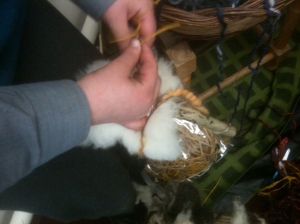
Total Individual Children Participating: 191
Total Participation Rate: 391 (Some school classes have returned 2-3 times)
“The kids really enjoyed the day. The presentation was excellent and language used was very child friendly, which made it very easy for the children to access what can be difficult concepts for even adults to grasp. Very enjoyable” Collon National School, Teacher (3rd Class)
The website Nature-Art-Education (www.naturearteducation.org) is a collection of resources for artists interested in working with natural materials, landscape and atmospheric conditions. The website has emerged from the projects and writings of artists, academics, philosophers, and community activists interested in arts based environmental education. The website was developed by artists based in Aalto University, School of Art and Design, Helsinki.
One of the articles included in this website is called “An Artist’s Way of Knowing” by Peter London. Peter London has written a book called Drawing Closer to Nature, which examines how nature can be a source of artistic practice, and a means of re-making our personal and collective experiences. He believes it is vital that everyone has primary encounters with nature, in order to cultivate enhanced experiences of intuition. Intuition is an artist’s way of knowing, and it is essential to making art that evokes personal experience.
Experimenting with natural materials is an opportunity for children to be alone with themselves amidst classroom activity. This time apart from structured learning can offer a short pause in which a child can rejuvenate focus. The advantage of a nature based classroom environment is to signal the necessary of inward retreat. A child can be stimulated by the re-making of a classroom, through collections of natural objects, writings, sculptures, photographs and indoor shelters or dens which engage the senses and offer a place for reflection.
The idea of a classroom also being an art studio suggests the importance of process and discovery within art making. The preciousness of a studio is to “inhabit a tiny microclimate, a wee ecosystem in which I am the main determinant.” (Peter London).
The Landmarks studio, located within the Ardee Library, is an opportunity for children to develop their own insight, perspective and to make a small habitat for themselves. A studio allows children to create a flow of artworks that carry their own insights and ways of being into the world. Artists “see the possibility of the new,” art is an activity of making and for children this activity can “act out in the manifest world, their singular experiences, intuitions, and reveries” (Peter London).
The photos were taken from a Landmarks workshop with Collon National School 3rd Class students.
Nature Based Art Installations for the Classroom
January 17, 2011
 Art installations can create three dimensional spaces within classrooms. They are environments for learning, and offer children a place for retreat – a space to restore energy and inspiration.
Art installations can create three dimensional spaces within classrooms. They are environments for learning, and offer children a place for retreat – a space to restore energy and inspiration.
Within the classroom , nature (within the reach of children) has been associated with imaginative replenishment. Re-charging the creative ideas of children can be beneficial for learning in a variety of subject areas. The idea of an art installation made from natural materials, can stimulate the senses, it is an opportunity to encourage children to ‘get in touch’ with the world around them. The physicality of building up an artistic space over time, brings the idea of the nature table to new levels. Using natural art materials (i.e. wood, mud, charcoal, river water, seeds, leaves, flowers, etc.) invigorates perception, by linking physical experience to ideas. Using nature to re-shape classroom experience and space, can invite new ways of looking at social relationships, language and the qualities of mathematical arrangements. Patterns, processes of change, symbolic representations, descriptions and experimental reasoning can be activated through artistic practice.
 The Children and Nature Network (www.childrenandnature.org) has a selection of research publications which attest to the fact that nature is good for children. Besides the benefits of increasing children’s time outdoors, there is also a case to be made for bringing the outdoors into the immediacy of children’s lives within classrooms. The textures and details of nature, as an artistic medium of expression, encourages exploration, observation and the sharing of experience. Art can express feelings and cognition, it can also spark ways of communicating our experience with others. It highlights our relationship with surroundings, and it can offer children a means of influencing their sense of place.
The Children and Nature Network (www.childrenandnature.org) has a selection of research publications which attest to the fact that nature is good for children. Besides the benefits of increasing children’s time outdoors, there is also a case to be made for bringing the outdoors into the immediacy of children’s lives within classrooms. The textures and details of nature, as an artistic medium of expression, encourages exploration, observation and the sharing of experience. Art can express feelings and cognition, it can also spark ways of communicating our experience with others. It highlights our relationship with surroundings, and it can offer children a means of influencing their sense of place.
The artworks shown were part of a classroom based art installation made by the students of St. Colman’s Abbey Education Centre, Newry, County Down, Northern Ireland. The project was sponsored by Sticky Fingers Arts for Young Children.




